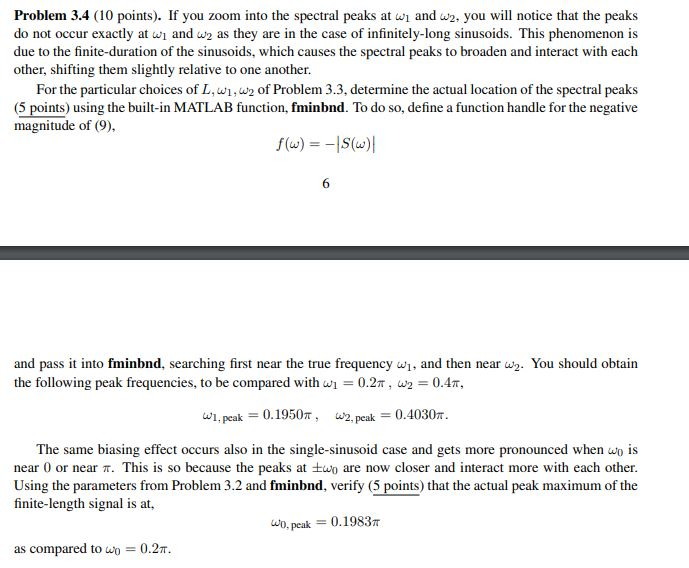Answered step by step
Verified Expert Solution
Question
1 Approved Answer
parameters from 3.2 and 3.3 Problem 3.4 (10 points). If you zoom into the spectral peaks at wi and w2, you will notice that the




parameters from 3.2 and 3.3
Problem 3.4 (10 points). If you zoom into the spectral peaks at wi and w2, you will notice that the peaks do not occur exactly at wi and we as they are in the case of infinitely-long sinusoids. This phenomenon is due to the finite-duration of the sinusoids, which causes the spectral peaks to broaden and interact with each other, shifting them slightly relative to one another. For the particular choices of L,w1,w2 of Problem 3.3, determine the actual location of the spectral peaks (5 points) using the built-in MATLAB function, fminbnd. To do so, define a function handle for the negative magnitude of (9), f(W) = -S(W) and pass it into fminbnd, searching first near the true frequency w1, and then near w2. You should obtain the following peak frequencies, to be compared with wi = 0.2, W2 = 0.47, w1, peak = 0.1950, W2,peak = 0.4030. The same biasing effect occurs also in the single-sinusoid case and gets more pronounced when wo is near 0 or near. This is so because the peaks at two are now closer and interact more with each other. Using the parameters from Problem 3.2 and fminbnd, verify (5 points) that the actual peak maximum of the finite-length signal is at, wo,peak = 0.1983 as compared to wo = 0.29. Problem 3.2 (10 points). Consider a length-L finite portion of a sinusoid of frequency wo, defined as the sinusoidally modulated pulse signal p(n) of Problem 3.1: sin(won), s(n) = sin(won) p(n) = { 10, if 0Step by Step Solution
There are 3 Steps involved in it
Step: 1

Get Instant Access to Expert-Tailored Solutions
See step-by-step solutions with expert insights and AI powered tools for academic success
Step: 2

Step: 3

Ace Your Homework with AI
Get the answers you need in no time with our AI-driven, step-by-step assistance
Get Started


